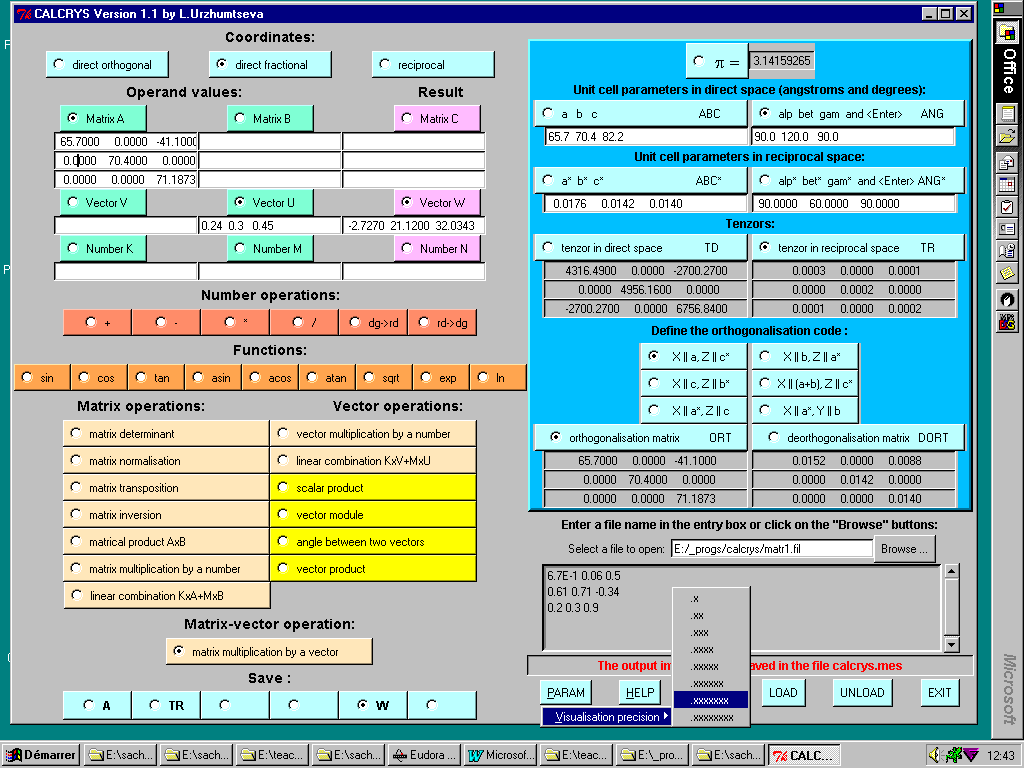Newsletter contents...

TCL/TK BASED PROGRAMS : CRYSTALLOGRAPHIC CALCULATOR
by
L.M. Urzhumtseva & A.G. Urzhumtsev
LCM3B, UPRESA 7036 CNRS, B.P.239, Faculté des Sciences, Université Nancy I, 54506, Vandoeuvre-lès-Nancy, France. E-mail: sacha@lcm3b.u-nancy.fr
Structural crystallography needs a number of simple algebraic calculations in order to measure lengths, angles, define relations between molecules, transformations of the coordinates, etc. These calculation can be done by general means, e.g. with a usual calculator or with a computer using standard mathematical complexes. Another possibility is to have a specialised tool, tuned particularly to these calculations, easy to call and to use, fast to address.
A new program in the suite of Tcl/tk based programs (Urzhumtseva & Urzhumtsev, 1996-1999), named CALCRYS, has been developed. This program allows to work with vectors defined in real or in reciprocal three-dimensional space, expressed in Cartesian or crystallographic (fractional) co-ordinates. Unit cell can be defined also either in real or in reciprocal space. When the cell is defined, its parameters in the conjugate space and all metrical tensors are calculated automatically. The optional choice of the orthogonalisation agreement allows to establish automatically the orthogonalisation and deorthogonalisation matrices. This crystallographic information presents permanently at the screen (Fig. 1).
The list of available algebraic operations includes the calculation of a linear combination of vectors, of their scalar and vector product (taking into account the corresponding metrical tensors), product of a matrix by a vector or by another matrix, a linear combination of matrices, matrix inversion, matrix determinant etc. These operations are grouped in a menu displayed near the set of work windows containing the data with which these operations are executed.
One more field contains a number of "memory cell" which allow to save intermediate results (any mixture of numbers, vectors or matrices) and to use them later.
Information can be inserted into the working windows in several ways : copied from the crystallographic field, from the memory cells, directly typed or read from a file.
CALCRYS is programmed completely in Tcl/tl (Ousterhout, 1993) which gives a possibility to run the same script directly under Windows in PC, in SGI or in AlphaDEC computer.
The program can be used by researchers as well as by students and teachers of crystallography. It is available by request from the authors. Reported "bugs" are welcome.
The authors thank P. Allé and O. Louis for technical assistance and C. Lecomte for the interest to the work.
References.
Ousterhout, J.K. (1993) "Tcl and the Tk Toolkit". Addison-Wesley Publishing Company.
Urzhumtseva, L.M., Urzhumtsev, A.G. (1996) "
Tcl/Tk-based programs. I. CONFOR : user-friendly converter for crystallographic data files". CCP4 Newsletter on Protein Crystallography, 32b, 41-43
Urzhumtseva, L.M., Urzhumtsev, A.G. (1997) "Tcl/Tk based programs. II. CONVROT: program to recalculate different rotation descriptions". J.Appl. Cryst., 30, 402-410
Urzhumtseva, L.M., Urzhumtsev, A.G. (1998) " Programs Tcl/Tk based crystallographic software : current state and new programs Tcl/tk interface ". CCP4 Newsletter on Protein Crystallography, 35, 22-24
Urzhumtseva, L.M., Urzhumtsev, A.G. (1999) "Tcl/Tk based programs. III. CRITXPL: graphical analysis of the X-PLOR refinement log-files". J.Appl. Cryst., 32, 376-377


Newsletter contents...

